Wm. Knabe & Co.
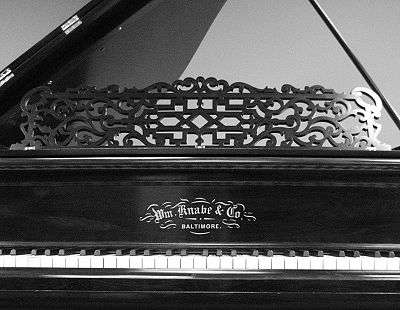
Wm. Knabe & Co. was a piano manufacturing company in Baltimore, Maryland from the middle of the nineteenth century through the beginning of the 20th century, and continued as a division of Aeolian-American at East Rochester, New York until 1982. It is currently a line of pianos manufactured by Samick Musical Instruments.
History
Wilhelm Knabe was born in Creuzburg, Saxe-Weimar, on June 3, 1803. The French campaigns in Germany in 1813 prevented him from studying to become an apothecary like his father, and instead he apprenticed with a cabinet maker, after which he worked two years as a journeyman cabinet maker, then for three years for a piano maker in Gotha, before working as a journeyman piano maker in different cities in Germany.
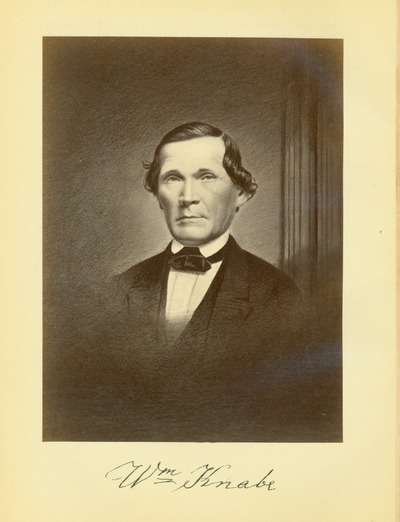
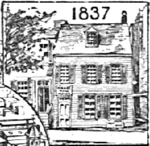
In 1831 Knabe accompanied his fiancée's family when they emigrated from Saxe-Meiningen to the United States, but the head of the family died during the voyage and Knabe and his bride remained in Baltimore instead of continuing to Hermann, Missouri, where a brother had settled several years earlier. Knabe worked for the well-known pianomaker Henry Hartge, and eventually abandoned his plans to become a farmer. Four years later he started selling and repairing used pianos from his house at the corner of Liberty and Lexington Streets.
Knabe & Gaehle
In 1839, Knabe formed a partnership with Henry Gaehle for the purpose of manufacturing pianos and by 1841 they moved to larger workshops at 13 South Liberty street.[1] In 1843 they opened warerooms at the corner of Eutaw street and Cowpen alley, and four years later removed their warerooms to 9 Eutaw street, opposite the Eutaw house, selling pianos priced between $180 and $400.[2] By 1852 they had expanded to 4, 6, 8, 9 and 11 Eutaw streets.[3] Knabe & Gaehle won first premiums for square pianos from the Maryland Institute for the Promotion of Mechanic Arts in 1848, 1849 and 1850, as well as for grand pianos in 1849.
In 1852, the company reorganized as Knabe, Gaehle & Co. with the admission of Edward Betts as partner,[4] and by 1853 advertised their establishment was the largest in the South, employing over 100 workmen.[5] They manufactured six to seven octave pianos with "a double action, like Chickering's" selling for between $200 and $500.[6]
In November 1854, their factory at Cowpen alley at the rear of Eutaw House burned, at an estimated loss of $190,000,[7] and five weeks later their factory at Baltimore street near Paca Street burned,[8] reportedly with little insurance coverage.
Wm. Knabe & Co.
Proceedings started early 1855 in order to dissolve the partnership.[9] Henry Gaehle died, and Knabe advertised he had purchased all the remaining stock and materials and would continue in business as Wm. Knabe & Co. at the old stand at 1, 3, 5, and 7 North Eutaw street, opposite the Eutaw house.[10] William Gaehle, who had become the senior partner, advertised he was in business as Wm. Gaehle & Co., manufacturing grand and square pianos at the corner of Pratt and Green streets and with warerooms at the corner of Eutaw and Fayette streets.[11]
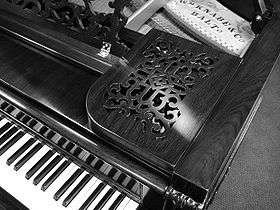
Knabe purchased a former paper mill at the corner of West and China streets for a new factory, and by 1859 had established warerooms at 207 Baltimore street.[12] He won gold medals for square pianos from the Maryland Institute in 1855, 1856, 1857 and 1858[13] silver medals from the Metropolitan Institute in Washington, D. C. in 1857, a medal from the Franklin Institute in Philadelphia in 1856, and first premiums from the Mechanics' Institute, Richmond, Virginia in 1855 and 1856.[14]
In 1860, Knabe started building a new five story factory on Eutaw and West streets, but had only completed one of its wings at the outbreak of the American Civil War, which compelled them to seek new trade in the West to make up for the loss of their principal market in the South.[15] William Knabe died May 21, 1864, and was succeeded by his sons William and Ernest J. Knabe , and son-in-law Charles Keidel.
In 1866, Wm Knabe & Co. introduced their agraffe treble with agraffes threaded into a heavier piece of brass instead of directly into the iron frame.[16]
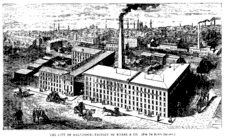
By 1866 they employed about 230 workmen and manufactured about a thousand pianos a year,[17] including uprights as well as squares and grands, producing as many as thirty pianos a week. The factory was equipped with a 30 horsepower (22 kW) steam engine, as well as steam powered elevators and drying rooms, and had been augmented with a second 40-foot (12 m) wide building where grand cases, sounding boards, and actions were manufactured and cases varnished and iron frames gilded.[18] Further additions and a cupola completed the factory in 1869, fronting 210 feet (64 m) on Eutaw street and 165 feet (50 m) on West street.[19] Their sales ranked third in the United States, after Steinway & Sons of New York and Chickering & Sons of Boston,[20] and by 1870 their output was estimated to be about forty pianos a week, priced between $600 and $2,000.[21]
In 1873, Wm. Knabe & Co. established their own warerooms at 112 Fifth Avenue in New York. They exhibited grand, square, and upright pianos as well as a Tschudi & Broadwood harpsichord at the 1876 Centennial Exposition in Philadelphia,[22] and due to the revised awards system they claimed highest honors along with many of their coexhibitors.[23] In 1882 they delivered a rosewood concert grand to the White House for President Chester A. Arthur.[24]
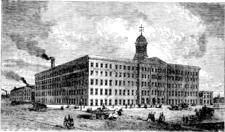
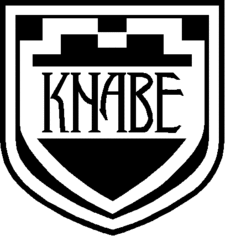
William Knabe, jr., died in 1889.[25] The company was incorporated with a capital stock of $1,000,000 the same year, with Ernest J. Knabe as president.
Ernest J. Knabe died in 1894[26] and was succeed by his sons, both of whom had trained at the factory. Ernest J. Knabe, jr. was elected president and William Knabe, vice president and treasurer.[27]
Wm. Knabe & Co. established agencies in Canada and England by 1903, and mortgaged the factory for the purpose of extending the business further.[28] By 1906 the factory occupied seven buildings with the original buildings extensively expanded, with a total of about 300,000 square feet (28,000 m2) of carefully planned floor space[29] and 765 employees. Although the plant included modern appliances such as individually powered machines and a dust collection system connected with the boiler, Knabe advertised their standards required their pianos to be carefully handcrafted, so that a plain upright took six months and a grand two years to complete.[30]
American Piano Co.
In 1908, Wm. Knabe & Co., with Chickering & Sons and the Foster-Armstrong Co., of East Rochester, New York, formed the American Piano Co. under the laws of New Jersey, headed by Ernst J. Knabe, Jr., president, and C. H. W. Foster of Chickering & Sons, and George G. Foster, of Foster-Armstrong, controlling their respective companies as well as Haines Brothers, Marshall & Wendell, Brewster, and J. B. Cook & Co. with a combined output of about 18,000 pianos a year.[31]
Knabe Brothers
Ernest and William Knabe resigned their positions in 1909, and following a series of business troubles in New York[32] they incorporated Knabe Brothers in Ohio in 1911, with offices at Cincinnati,[33] manufacturing upright and grand pianos at a former Smith and Nixon factory in nearby Norwood,[34] "free from the yoke of a commercialism that figured out pianos by square inches of wood and decimal points in the allotment of wires".[35] American Piano Co. filed suit over the use of the name but the resulting injunction only prevented Knabe Brothers from using their original nameboard label, and required the brothers to indicate this was a new company.[36] The plant burned in January 1912,[37] but they quickly resumed production at a temporary factory[38] before building a modern factory on the old site. The company went into receivership late in 1916 on account of an unpaid loan,[39] and the brothers declared bankruptcy by the end of the year.[40]
Ernest J. Knabe died in 1927,[41] and William Knabe died 1939.[42]
Ampico
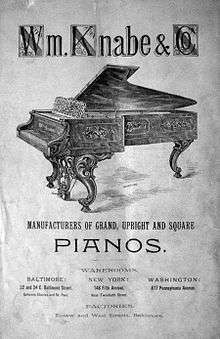
In 1927 Wm. Knabe & Co. removed their New York warerooms from 437 Fifth avenue at 39th street to 657 Fifth avenue, corner of 52nd Street,[43] and in 1928 moved to Ampico Tower at Fifth avenue and 47th street as part of American Piano Co.'s move to consolidate the sales of all their brands[44] in an unsuccessful attempt to make up for a sharp decline in profits. American went into receivership in 1929, and Knabe's liabilities were listed as $286,000 and assets $415,000.[45]
_1935.jpg)
In 1930 American's assets were purchased by the American Piano Corporation, newly incorporated under the laws of Delaware, whose officers included former executives from American as well as executives from the Aeolian Corporation.[46] The Knabe factory was closed, as well as the Chickering factory in Boston, and their production ultimately transferred to East Rochester, New York, where they were established as separate divisions. The old factories, including Mason & Hamlin in Boston and the Amphion in Syracuse, New York, were put on the market.[47]
In the late 20th Century, the abandoned Baltimore Knabe factory at Eutaw and West streets was razed to make way for the Baltimore Ravens' football stadium. A sidewalk keyboard mosaic on the southwest corner of the stadium honors the Knabe legacy. The cupola that was located atop the factory now stands on the grounds of the Baltimore Museum of Industry.[48][49]
Aeolian-American
In 1932 the American Piano Corp. merged with the Aeolian Company, Aeolian-Weber's piano subsidiary, to form the Aeolian American Corporation which consolidated the control of more than 20 piano brands,[50] as well as action manufacturing and plate casting divisions.[51] In 1936 it ranked as the fourth largest producer in the country, after Kimball, Baldwin and Winter & Co.[52]
Berthold Neuer, who had been vice president and general mangager from 1927[53] died in 1938,[54] and his successor Richard K. Paynter died in 1940[55]
In 1942, the East Rochester factories were contracted to manufacture military aircraft parts, keeping the plants and personnel in operation,[56] but by late 1949 piano production returned to full capacity.[57] The Aeolian Company and the American Piano Corporation recapitalized and merged with the Aeolian-American Corporation in 1951,[58] and in 1957 was purchased by the owners of Winter & Co., based in Bronx, New York.[59]
By 1981, the combined divisions at the East Rochester factory employed about 300,[60] and it closed the following year.[61]
Sohmer & Co.
In 1985, Sohmer & Co. purchased the Knabe and Mason & Hamlin trademarks and their patterns and equipment from Citicorp Industrial Credit Co., Aeolian's principal creditors. Sohmer & Co. had planned to resume production of the existing models from both divisions but was itself sold and the companies reorganized with Sohmer and Knabe as subsidiaries of Mason & Hamlin.[62]
Knabe admirers
- Antoine François Marmontel
- Heinrich Schulz-Beuthen
- Leopold Damrosch
- Hans von Bülow
- Camille Saint-Saëns
Today
Wm. Knabe & Co. pianos are manufactured by Samick Musical Instruments, Ltd., which acquired the name from PianoDisc, owners of Mason & Hamlin, in 2001.[63]
As of 2007, Knabes are offered in three sizes of vertical pianos – a 119 cm (47 inches) in three furniture case styles, as well as 121 cm (48 inches) and 131 cm (52 inches) models – and four sizes of grand pianos – three case styles each of 158 cm (5 feet 3 inches) the WKG53, 173 cm (5 feet 8 inches) the WKG58, 193 cm (6 feet 4 inches) the WKG64, and 215 cm (7 ft) WKG70 models.
In early 2006, Samick Music Corporation, distributor for Samick in the United States and Canada announced they had started building a 210,000-square-foot (20,000 m2) distribution center and factory in Gallatin, Tennessee where they plan to manufacture Knabe as well as J. P. Pramberger lines beginning late 2006 or early 2007.[64]
The famed, Elvis White Piano is being auctioned on eBay August 10th - 20th.[65]
References
- "William Knabe" Baltimore: Past and present, with Biographical Sketches of its Representative Men. Richardson & Bennett, Baltimore, 1871. p. 349–352
- ↑ The Baltimore Directory for 1845, John Murphy, Baltimore, 1845 p.80
- ↑ advertisement Matchetts Baltimore Director, for 1847–'8 R. J. Matchett, Baltimore. 1847 p.448.
- ↑ advertisement Baltimore Wholesale Business Directory and Business Circular, for the Year 1852 I. Hartman, Baltimore, 1852 p.21
- ↑ advertisement Adams Sentinel and General Advertiser Gettysburg, Pennsylvania March 29, 1852
- ↑ advertisement Baltimore Wholesale Business Directory and Business Circular, for the Year 1853 I. Hartman, Baltimore, 1853 p.28
- ↑ advertisement (Erie Music Store) The Erie Observer Erie, Pennsylvania, March 11, 1854 p.4 (issued November 12, 1853)
- ↑ David A. Dana The Fireman: The Fire Departments of the United States, with a Full Account of All Large Fires James French and Company, Boston. 1858 p.254; the stock alone was valued at $60,000 – "Large Fire in Baltimore" New York Times November 6, 1854 p.4
- ↑ J. Thomas Scharf The Chronicles of Baltimore; being a Complete History of "Baltimore Town" and Baltimore City from the Earliest Period to the Present Time Turnbull Brothers, Baltimore 1874 p.547
- ↑ William Knabe vs. Henry Gaehle and Edward Betts. Dissolution of Knabe, Gaehle & Co. C17 Baltimore City Superior Court (Chancery Papers) MSA C168; Accession No. 40,200-5143-1/14, MSA No. C168-747 Location: 2/16/6/14. January 17, 1855
William Gaehle vs. William Knabe, Edward Betts, and Western Bank of Baltimore. Dissolution of Knabe, Gaehle & Co. C30 Baltimore City Superior Court (Chancery Papers) MSA C168; Accession No. 40,200-5371 MSA No. C168-978 Location: 2/16/6/32 August 31, 1857 - ↑ advertisement Woods' Baltimore Directory, for 1856–'57 John W. Woods, Baltimore p.179
- ↑ advertisement Wood's Baltimore Directory 1856, p.119
- ↑ advertisement Philadelphia Press, Mar. 21, 1859
- ↑ "Pianos! Pianos!" The Republican Compiler Gettysburg, Pennsylvania, January 18, 1859 p.2; reportedly Knabe only had seven weeks after the dissolution of Knabe, Gaehle & Co. to prepare his piano for the fair in 1855
- ↑ advertisement The Republican Compiler April 18, 1859 p.3
- ↑ Spillane p.133; James W. Sheahan and George P. Upton The Great Conflagration. Chicago: Its Past, Present and Future. Union Publishing Co., Chicago. p.354; Julius Bauer & Co. acted as Knabe's Northwestern agent as well as their New York agent from 1862 until 1873
- ↑ William Nordhoff "Improvement in Pianos" United States Patent no. 57,257 April 14, 1866
- ↑ James Parton "The Piano in the United States" The Atlantic monthly vol.20 no.117 p.93
- ↑ "The Piano Forte Manufactory of Knabe & Co., Baltimore" Debow's review, Agricultural, commercial, industrial progress and resources. vol.2, no.1, p. 71-73
- ↑ "The Great Southern Piano Manufactory" Debow's review, Agricultural, commercial, industrial progress and resources. vol.1, no. 2, 1866, p. 209
- ↑ "Piano-fortes" The Great Industries of the United States: Being an Historical Summary of the Origin, Growth, and Perfection of the Chief Industrial Arts of this Country J. Burr & Hyde, Hartford. 1873. p331
- ↑ "The Knabe Piano" The Columbia Spy Columbia, Pennsylvania August 20, 1870 p.3
- ↑ International Exhibition, 1876. Official Catalogue John R. Nagle and Company, Philadelphia. 1876. p.265
- ↑ "Piano Award – Knabe Victory – Unanimous Award of Highest Honors to William Knabe & Co." New York Times October 1, 1876; all of the awards had equal value, but each included specific comments from the judges that the exhibitors could publish as they saw fit – "The Centennial Awards" New York Times September 28, 1876.
- ↑ "A Knabe in the White House" New York Times December 16, 1882 p.5
- ↑ Daniel Spillane History of the American Pianoforte D. Spillane, New York. 1891. p.132
- ↑ Henry Hall, ed. America's Successful Men of Affairs vol.2 The New York Tribune, New York. 1896 p.477
- ↑ Alfred Dolge Pianos and their Makers vol.2, Covina Publishing Company, Covina CA, 1913. p.121.
- ↑ "Knabe Company Extension – Bond Issue of $450,000 Made by Manufacturers" New York Times May 2, 1903
- ↑ "Three Generations of Piano Manufacturers" McClure's Magazine vol.26, The S. S. McClure Co., New York and London. 1906 advertising section p.16m-16n
- ↑ "Inspired Handiwork" The American Monthly Review of Reviews vol.24 1906. advertising section p.41
- ↑ "Piano Makers form $12,000,000 Combine" New York Times June 10, 1908 p.5
- ↑ "United Surety Loses License" New York Times May 2, 1910
- ↑ "Knabe Bros. Co." The Newark Advocate Newark, OH, May 5, 1911 p.12
- ↑ William N. Osborne Music in Ohio Kent State University Press, Kent Ohio 2004 p.494
- ↑ advertisement The Newark Advocate February 25, 1913 p.7
- ↑ Six, Baer & Fuller Dry Goods Co. et al. v. American Piano Co. (211 Fed. Rep., 271.) 8th Circuit, November 28, 1913 The Trade-Mark Reporter vol. 4, The United States Trade-mark Association, New York. 1914 p.246
- ↑ "Fires" The American Library Annual, 1913 Publishers' Weekly, 1913, New York. p.38; the value given is $100,000
- ↑ "Knabe Brothers Piano Company" The Newark Advocate February 29, 1912 p.8
- ↑ "Receiver for Piano Company" Van Wert Daily Bulletin Van Wert, OH December 9, 1916 p.1; the note was for $100,000
- ↑ "Pianomakers in Bankruptcy" New York Times December 31, 1916. p.17; Their combined liabilities were more than $660,000 and their declared assets amounted to $476.38
- ↑ "E. J. Knabe Found Dead" New York Times September 28, 1924 p.S8
- ↑ "William Knabe, 66, Piano Manufacturer" Special to the New York Times March 1, 1939 p.27
- ↑ advertisement New York Times April 14, 1927
- ↑ "William Knabe & Co. Move" New York Times March 1, 1928; "Piano Salesrooms United" New York Times September 26, 1928 p.45
- ↑ "Business Records" New York Times December 27, 1929, p.45
- ↑ "Change in American Piano" New York Times May 22, 1930 p.47
- ↑ "The American Piano Company" Harvard Business School case study, 1934, reproduced in the AMICA Bulletin and available from the Pianola Society
- ↑ Gunts, Edward. "Going, going: Last of city's giant gas holders coming down," The Baltimore Sun, Friday, October 19, 2012.
- ↑ "Wm. Knabe & Co. Piano Forte Factory," Baltimore History Bits, Tuesday, September 6, 2011.
- ↑ "Deals & Developments" Time Magazine August 8, 1932
- ↑ "Piano Merger Links 2 Largest Makers" New York Times July 30, 1932. p.17
- ↑ "Merchants of Music" Time Magazine August 10, 1936
- ↑ "Now Knabe's Vice President" New York Times June 1, 1927 p.37
- ↑ obituary New York Times July 1, 1938 p.19
- ↑ obituary New York Times August 10, 1940 p.13
- ↑ "Piano Industry to be Converted" New York Times June 22, 1942 p.23
- ↑ "Piano Producers Optimistic on Fall" New York Times July 28, 1949
- ↑ "Aeolian-American Merger" New York Times May 18, 1951. p.54
- ↑ Trademark Assignment Details, Reel/Frame 0053/0478 May 21, 1959; Reports of the Tax Court of the United States Government Printing Office, Washington, D. C., 1969. p.110
- ↑ Susan Caust Farrell, Directory of Contemporary American Musical Instrument Makers University of Missouri Press, Columbia MO 1981 p. 2
- ↑ Pierce Piano Atlas 9th ed.
- ↑ Larry Fine. The Piano Book Brookside Press, Boston. 1987 p.100; Leslie Brokaw, "Sour Notes" Inc. Jan 1990
- ↑ "Samick Acquires Wm. Knabe & Co." Music Trades March 1, 2001
- ↑ Samick Music Corp. to Relocate North American HQ to Tennessee Expansion Management February 10, 2006
- ↑ Wm. Knabe & Co piano was built in 1912 and installed in the Music Room for 12 years eBay.com August 10, 2017
External links
- Knabe Pianos
- Samick Musical Instruments, Ltd.
- Samick Music Corporation
- Knabe Pianos, 148–152 5th Ave., SW corner of 20th St. (2004) New York City Signs – 14th to 42nd Street
- James Bartel Knabe Pianos WGMS-Classical 103.5, Washington, D. C. 2002